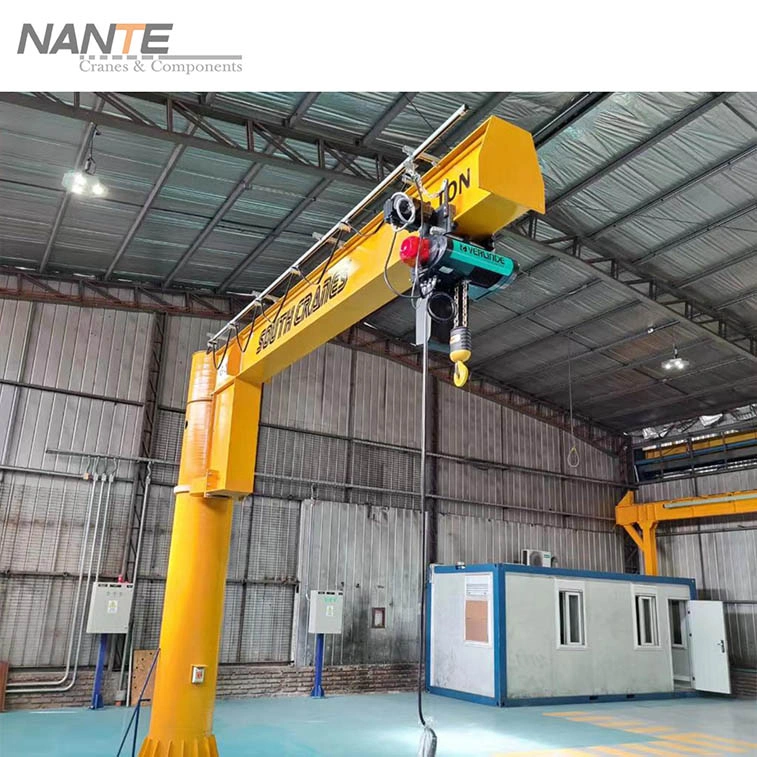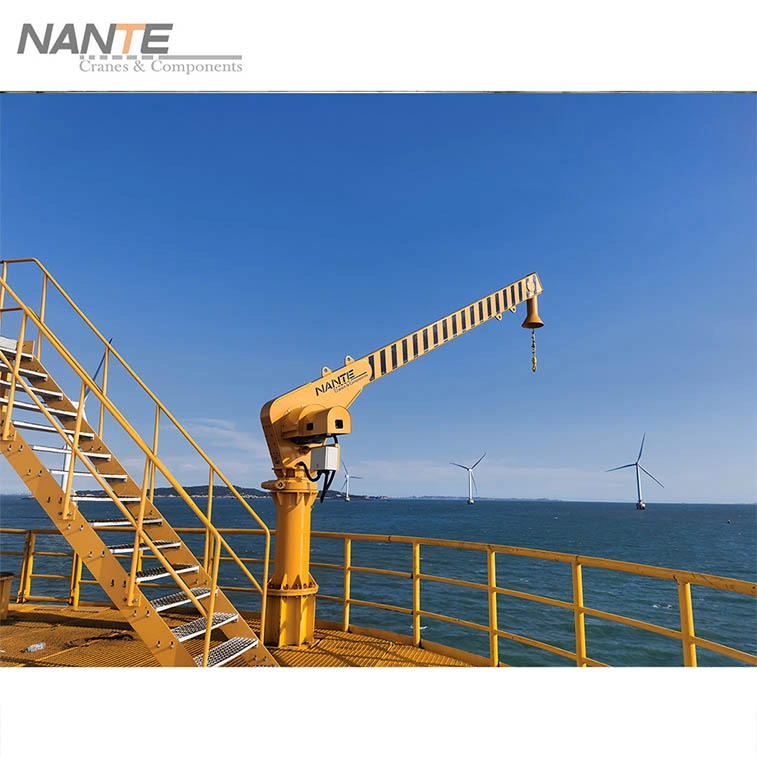Jib Cranes vs Davit Cranes: A Breakdown of 4 Key Differences
Jib Cranes vs Davit Cranes: A Breakdown of 4 Key Differences
Date: 2025-08-01 Share:
Introduction
Jib cranes and davit cranes are super handy for lifting stuff in all sorts of industries. But their different designs and abilities can cause mix-ups. Both have boom-like arms for moving things around. Yet, their build, how they work, and best uses are pretty different. Knowing these differences helps pick the right gear for safety, speed, and saving cash. This breakdown dives into four big differences: structural design, load capabilities, operational mechanics, and industry applications.
1. Structural Design & Mounting: Fixed vs Flexible Foundations
Jib cranes and davit cranes have unique builds and setups. These affect where they work best.
Jib Cranes
Jib cranes are all about staying put. They’re built tough and set in one spot. A vertical column, either freestanding or wall-mounted, holds a spinning horizontal arm. They need strong bases to handle heavy lifting forces:
- Freestanding jibs need concrete bases or deep foundations for steadiness.
- Wall-mounted jibs lean on building columns, often spinning only up to 270 degrees.
- Made from sturdy stuff like steel or aluminum I-beams and box girders, jib cranes are all about strength and rigidity.
Davit Cranes
Davit cranes are built for moving around. They’re easy to set up. They use telescopic or folding masts with portable bases, wall brackets, or flanges. No permanent bases needed:
- Many can be ready in minutes, perfect for short-term or tight spots.
- Light materials, like aluminum or carbon fiber, make them easy to carry.
- They’re common on ship decks or emergency repair sites.
Key Takeaway: Jibs are great for fixed spots. Davits shine in temporary or cramped places like ship decks or quick-fix sites.
2. Load Capacity & Reach: Precision vs Rescue Readiness
Jib cranes and davit cranes handle different lifting jobs. Their load capacities and reach vary a lot.
Jib Cranes
Jib cranes are made for heavy industrial lifting. They have big load capacities and long reach:
- Max Capacity: Up to 16 tons.
- Boom Length: Up to 16 meters.
- Lifting Height: Up to 12 meters.
- Rotation: Spins 180° to 360° for full coverage in a set area.
These make jib cranes awesome for moving big machines in factories or shifting parts in workshops.
Davit Cranes
Davit cranes focus on lighter, special tasks, often for rescues or repairs:
- Max Capacity: Usually up to 1 ton.
- Boom Length: Mostly 5 meters or less.
- Lifting Height: Shorter, focusing on vertical rescue or pickup.
- Rotation: Has adjustable boom angles and rotation for flexibility.
Davit cranes often have safety features like 21kN-rated anchors, great for marine rescues or tight-space jobs.
Specification Comparison
| Specification | Jib Cranes | Davit Cranes |
| Max. Capacity | Up to 16 tons | Typically ≤1 ton |
| Boom Length | Up to 16 m | ≤5 m |
| Lifting Height | Up to 12 m | Lower (focus on rescue) |
| Rotation | 180°–360° fixed radius | Adjustable boom angle + rotation |
Jibs rule for heavy lifting, like moving 5-ton machines in factories. Davits are tops for controlled drops, like lowering people in marine rescues, with features like 21kN-rated anchors.
3. Operational Mechanics: Automation vs Manual Agility
Jib cranes and davit cranes work differently, matching their intended uses. Jibs lean on automation. Davits focus on manual flexibility.
Jib Cranes
Jib cranes often use motors for zippy work and easy blending with automated setups:
- Motorized Slewing: Spins 360° for exact positioning.
- Hoisting Mechanisms: Use chains or wire ropes for lifting.
- Automation Compatibility: Can be set for repeat tasks, perfect for assembly lines or factories.
This automation makes jib cranes super efficient for steady, high-volume lifting.
Davit Cranes
Davit cranes go for manual ease and adaptability:
- Hoisting Methods: Use hand-cranked or electric winches for vertical lifts.
- Telescopic Arms: Let workers tweak reach and angle on the fly.
- Manual Agility: Great for random tasks, like grabbing gear from water or fixing stuff in tight spots.
Davit cranes have safety tricks, like emergency brakes and storm-proof designs, for trusty work in rough conditions.
Safety Note: Davits come with emergency brakes and storm-proof builds for tough settings.
4. Industry Applications: Manufacturing vs Marine & Mobility
Choosing between jib cranes and davit cranes depends on the industry and job needs.
Jib Cranes Thrive In
- Workshops: Loading CNC machines or moving parts between spots.
- Warehouses: Fixed-point lifting with 360° coverage for handling stuff.
- Construction: Helping tower cranes with material staging and exact placement.
Jib cranes are must-haves for heavy lifting in set locations.
Davit Cranes Specialize In
- Marine: SOLAS-compliant lifeboat handling, key for ship safety.
- Emergency Services: Rescues in tight spots like tanks or silos.
- Maintenance: Portable access for bridge checks, turbine fixes, or high-reach jobs.
Davit cranes are vital for mobile, quick-setup tasks like marine safety or emergency response.
Market Trend
Jib crane demand is growing in manufacturing, with a 6% yearly growth rate expected by 2032, thanks to automation and industry growth. Davit cranes stay big in offshore safety and marine jobs, where their portability and special features are key.
Spotlight: Industry-Leading Crane Solutions Provider
Nante Crane, based in Shaoxing, China, is a leading provider of advanced lifting systems, offering a wide range of overhead cranes for complex industrial applications.
Their offshore davit cranes are designed for marine environments, ensuring reliability in harsh conditions with features like ISO C5-H coatings, waterproof motors, and 360° rotating hook blocks for safety. These cranes are perfect for offshore lifeboat deployment, marine rescues, and hoisting operations.
In addition, Nante’s jib cranes are ideal for workshops and manufacturing environments, offering flexible designs such as free-standing and wall-mounted types. Their cranes feature high-quality materials, motorized or manual slewing, and can handle loads efficiently in compact spaces.
With a global reach and a commitment to safety and durability, Nante provides tailored lifting solutions that meet international standards.
FAQ: Key Questions Answered
Can a davit crane replace a jib crane in a factory?
Not really. Davit cranes don’t have the reach or capacity for heavy factory lifts. But they’re handy for lighter maintenance tasks.
Which crane is safer for offshore use?
Davit cranes are built for offshore, with corrosion resistance, storm-proof designs, and rescue features, making them safer there.
Do jib cranes require building modifications?
Yup. Freestanding jib cranes need strong foundations. Wall-mounted ones need sturdy building columns to hold their weight and loads.
Take the Next Step
Ready to optimize your lifting operations? Download Nante’s technical guides for crane specifications, or schedule a consultation to design a custom solution. Ensure safety, efficiency, and compliance—connect with our engineers today.





